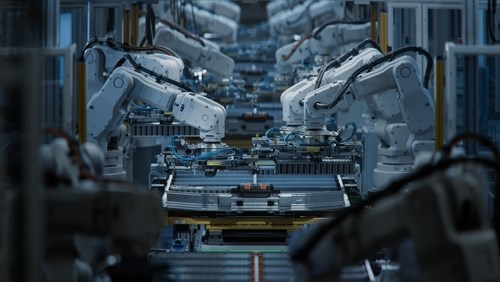
SCANOLOGY has just introduced NimbleTrack Gen2. With upgraded technology, SCANOLOGY's NimbleTrack Gen2 is capable of scanning large and complex areas significantly faster, while maintaining measurement-level accuracy. This is the next generation of the company's mobile optical tracking and 3D scanning systems. SCANOLOGY's NimbleTrack Gen2 is designed to deliver higher performance, especially in speed and measurement range.

A breakthrough opportunity for R&D processes awaits the Vietnamese engineering community. The specialized workshop "Driving Engineering Innovation Through Smart Simulation" organized by ANSYS will take place on October 29, 2025, at the Innovation Hub Building, updating the latest advanced simulation solutions for the manufacturing, electronics design, and Nano-Micro industries.

In the global race to automate manufacturing, China is emerging as a pioneer with the “dark factory” model – where robots and artificial intelligence completely replace humans. Requiring no light or rest, the new generation of factories operate continuously 24/7 with superior precision and efficiency.
According to a recent case study, one aerospace company found that its quality control workflow could be performed “twice as fast” with 3D laser trackers and metrology software when compared to doing the job without it.
In aerospace — whether that’s space travel, turboprop or jet manufacturing — a defect, mismeasurement, or slight error can be the difference between a successful launch and mission failure. It’s because of this that aerospace companies have the most stringent requirements for quality and dimensional accuracy.
![]()
Manufacturing aerospace parts that have such a high quality requirement is extremely challenging. With traditional post-machining inspections, many of these parts may have to be completely scrapped or reworked. This scrap and rework can lead to wasted material, production line halts, and supply chain issues for both the OEM and connected suppliers. In the end, this will lead to increased cost and delayed programs, results that are unacceptable for any market leader.
One way to greatly relieve these issues is to use portable metrology equipment such as laser trackers, CMM arms, and 3D metrology software. The equipment can be used to quickly inspect first articles, check pre-machined dimensions, and position the rough part to help ensure the machining will run smoothly — preventing the waste of material, energy and time.
Many aerospace parts are large. Because of this, the machining time for these parts is very high and the rework time can be very large. To minimize rework time, many operators will use 3D laser trackers and metrology software to verify the quality of the part during the machining process. This is a huge benefit, because it allows manufacturers to identify issues as they arise — ensuring that the operator can rework the part earlier and faster, plus ensuring the quality of the part when it’s pulled off the machine. Due to the high accuracy requirements and large part size, in-process verification like this is easiest when it’s done with high-quality 3D laser trackers.

According to a recent case study, one aerospace company found that its quality control workflow could be performed “twice as fast” with 3D laser trackers and metrology software when compared to doing the job without it.
Finally, the machining equipment can also be calibrated using laser trackers. The laser tracker can measure the actual machine position versus the intended position over the full machine travel; this information can then be used to adjust machining parameters for more precise manufacturing. This will help improve the quality of future machined parts, reducing cost and schedule overruns.
After machining, assembling the parts into a final craft can be even more challenging because minor misalignments can lead to critical defects. This is an area where portable metrology solutions — including laser trackers and portable CMM arms — can be extremely powerful. To maximize production and minimize waste, aerospace organizations use these metrology solutions to measure the assembly quality and adjust it with real-time feedback from the metrology software. With this process, the operator can be certain that the final assembly will have the right dimension and they won’t have to rework it later. And when paired with powerful software with automation capabilities, this even allows operators at varied skill levels to feel confident in the execution of their tasks.
This shows how and why 3D laser trackers and metrology software are absolutely essential to the success of aerospace companies — both by ensuring quality meets the highest standards and also by using smarter tools to eliminate wasteful time, scrap and supply chain issues.

However, for an organization to successfully implement laser trackers in its process, there are a few essential requirements. OEMs should take all of these into consideration when updating and optimizing their workflows.
Important aspects of a 3D laser tracker solution for aerospace workflows:
1. Portability.
The metrology solution must be exactly that: portable! It must be capable of being transported to where the work is occurring. There’s no point in implementing a solution if it means opening a whole new quality control lab that will slow down operations. Parts need to be measured and quality needs to be checked on the production line itself for the most efficient operations. This is why laser trackers and portable CMMs are an innovative solution to the particular problem of aerospace quality.
Aerospace parts and assemblies are very large and bulky. Moving these large objects to the inspection lab can be time-consuming and the risk of damage during transport is low but very costly. Having portable measurement equipment means that OEMs can perform inspection or metrology-assisted assembly directly where the part is, reducing time, cost and risks.
(Continued)
Source: qualitymag
Read Quality Mastery magazine to get more information about quality management: https://qualitymastery.v-proud.vn/
If you are looking for quality management solutions, visit the following websites: v-proud.vn/product and doluongcongnghiep.vn.
#lasertracker #3D #CMM #portableCMM #aerospace #measuringarm #taydodidong
(84) 896 555 247